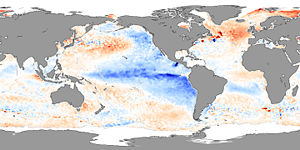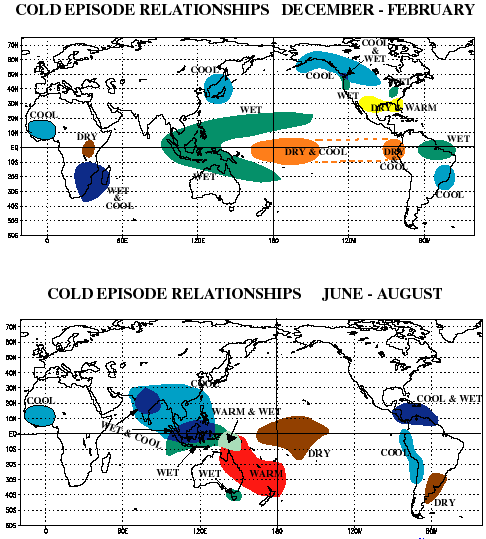
La Niña
Encyclopedia

El Niño-Southern Oscillation
El Niño/La Niña-Southern Oscillation, or ENSO, is a quasiperiodic climate pattern that occurs across the tropical Pacific Ocean roughly every five years...
climate pattern
Climate pattern
A climate pattern is any recurring characteristic of the climate. Climate patterns can last tens of thousands of years, like the glacial and interglacial periods within ice ages, or repeat each year, like monsoons....
. During a period of La Niña, the sea surface temperature
Sea surface temperature
Sea surface temperature is the water temperature close to the oceans surface. The exact meaning of surface varies according to the measurement method used, but it is between and below the sea surface. Air masses in the Earth's atmosphere are highly modified by sea surface temperatures within a...
across the equatorial Eastern Central Pacific Ocean
Pacific Ocean
The Pacific Ocean is the largest of the Earth's oceanic divisions. It extends from the Arctic in the north to the Southern Ocean in the south, bounded by Asia and Australia in the west, and the Americas in the east.At 165.2 million square kilometres in area, this largest division of the World...
will be lower than normal by 3–5 °C. In the United States, an episode of La Niña is defined as a period of at least 5 months of La Niña conditions. The name La Niña originates from Spanish
Spanish language
Spanish , also known as Castilian , is a Romance language in the Ibero-Romance group that evolved from several languages and dialects in central-northern Iberia around the 9th century and gradually spread with the expansion of the Kingdom of Castile into central and southern Iberia during the...
, meaning "the girl," analogous to El Niño meaning "the boy."
La Niña, sometimes informally called "anti-El Niño", is the opposite of El Niño, where the latter corresponds instead to a higher sea surface temperature by a deviation of at least 0.5 °C, and its effects are often the reverse of those of El Niño. El Niño is famous due to its potentially catastrophic impact on the weather along both the Chile
Chile
Chile ,officially the Republic of Chile , is a country in South America occupying a long, narrow coastal strip between the Andes mountains to the east and the Pacific Ocean to the west. It borders Peru to the north, Bolivia to the northeast, Argentina to the east, and the Drake Passage in the far...
an, Peru
Peru
Peru , officially the Republic of Peru , is a country in western South America. It is bordered on the north by Ecuador and Colombia, on the east by Brazil, on the southeast by Bolivia, on the south by Chile, and on the west by the Pacific Ocean....
vian and Australia
Australia
Australia , officially the Commonwealth of Australia, is a country in the Southern Hemisphere comprising the mainland of the Australian continent, the island of Tasmania, and numerous smaller islands in the Indian and Pacific Oceans. It is the world's sixth-largest country by total area...
n coasts, among others. La Niña is often preceded by a strong El Niño.
Effects

For India, an El Niño is often a cause for concern because of its adverse impact on the south-west monsoon; this happened in 2009. A La Niña, on the other hand, is often beneficial for the monsoon, especially in the latter half. The La Niña that appeared in the Pacific in 2010 probably helped 2010's south-west monsoon end on a favourable note. But then, it also contributed to the deluge in Australia, which resulted in one of that country's worst natural disasters with large parts of Queensland
Queensland
Queensland is a state of Australia, occupying the north-eastern section of the mainland continent. It is bordered by the Northern Territory, South Australia and New South Wales to the west, south-west and south respectively. To the east, Queensland is bordered by the Coral Sea and Pacific Ocean...
either under water from floods of unusual proportions or being battered by tropical cyclones, including that of category 5 Tropical Cyclone Yasi
Cyclone Yasi
Severe Tropical Cyclone Yasi was a tropical cyclone that made landfall in northern Queensland, Australia in the early hours of Thursday, 3 February 2011. Yasi originated from a tropical low near Fiji. The system intensified to a Category 3 cyclone at about 5pm AEST on 31 January 2011...
. It wreaked similar havoc in south-eastern Brazil and flooding that have affected Sri Lanka.
Recent occurrences
There was a strong La Niña episode during 1988–1989. La Niña also formed in 1995, and in 1999–2000. A minor La Niña occurred 2000–2001. The La Niña which developed in mid 2007 and lasted until early 2009, was a moderate one. NOAA confirmed that a moderate La Niña developed in their November El Niño/Southern Oscillation Diagnostic Discussion, and that it would likely continue into 2008. According to NOAA, "Expected La Niña impacts during November – January include a continuation of above-average precipitation over Indonesia and below-average precipitation over the central equatorial Pacific. For the contiguous United States, potential impacts include above average precipitation in the Northern Rockies, Northern California, and in southern and eastern regions of the Pacific Northwest. Below-average precipitation is expected across the southern tier, particularly in the southwestern and southeastern states.However, an El Niño returned in May–June 2009 and lasted until April 2010. The effects of El Niño in 2009 were already being seen in the fall of 2009 as the remnants of Tropical Storm Ida strengthened into a powerful coastal storm.
A new La Niña episode developed quite quickly in the eastern and central tropical Pacific in mid-2010, and lasted at least until early 2011. This La Niña, combined with record-high ocean temperatures in the north-eastern Indian Ocean
Indian Ocean
The Indian Ocean is the third largest of the world's oceanic divisions, covering approximately 20% of the water on the Earth's surface. It is bounded on the north by the Indian Subcontinent and Arabian Peninsula ; on the west by eastern Africa; on the east by Indochina, the Sunda Islands, and...
, has been a large factor in the 2010–2011 Queensland floods
2010–2011 Queensland floods
A series of floods hit Australia, beginning in December 2010, primarily in the state of Queensland including its capital city, Brisbane. The floods forced the evacuation of thousands of people from towns and cities. At least seventy towns and over 200,000 people were affected. Damage initially was...
, and the quartet of recent heavy snowstorms in North America starting with the December 2010 North American blizzard
December 2010 North American blizzard
The December 2010 North American blizzard was a major nor'easter and historic blizzard affecting the United States from portions of northern Florida to Maine and portions of Canada on December 26–27, 2010. It was the first significant winter storm of the 2010-11 winter season and the fourth North...
. The same La Nina event is also a likely cause of a series of tornadoes of above-average severity that struck the Midwestern and Northwestern United States in the spring of 2011, and is currently a major factor in the drought conditions persisting in the South Central states including Texas, Oklahoma and Arkansas.
"La Niña" events between 1950 and 2011.
See also
- El Niño-Southern OscillationEl Niño-Southern OscillationEl Niño/La Niña-Southern Oscillation, or ENSO, is a quasiperiodic climate pattern that occurs across the tropical Pacific Ocean roughly every five years...
(Main article on El NiñoEl Niño-Southern OscillationEl Niño/La Niña-Southern Oscillation, or ENSO, is a quasiperiodic climate pattern that occurs across the tropical Pacific Ocean roughly every five years...
and the related Southern Oscillation, discussing the relation between these two and La Niña) - Walker circulationWalker circulationThe Walker circulation, also known as the Walker cell, is a conceptual model of the air flow in the tropics in the lower atmosphere . According to this model parcels of air follow a closed circulation in the zonal and vertical directions...
- 2010 Pakistan floods2010 Pakistan floodsThe 2010 Pakistan floods began in late July 2010, resulting from heavy monsoon rains in the Khyber Pakhtunkhwa, Sindh, Punjab and Balochistan regions of Pakistan and affected the Indus River basin. Approximately one-fifth of Pakistan's total land area was underwater, approximately...
(attributed to La Niña) - 2010–2011 Queensland floods2010–2011 Queensland floodsA series of floods hit Australia, beginning in December 2010, primarily in the state of Queensland including its capital city, Brisbane. The floods forced the evacuation of thousands of people from towns and cities. At least seventy towns and over 200,000 people were affected. Damage initially was...
(attributed to La Niña) - 2011 Horn of Africa drought (attributed to La Niña)

